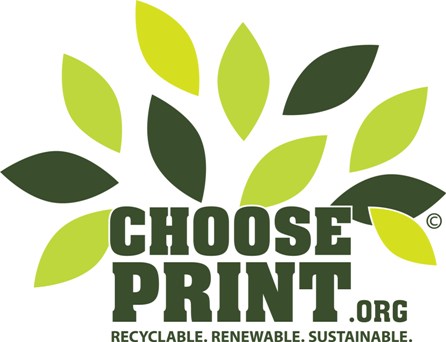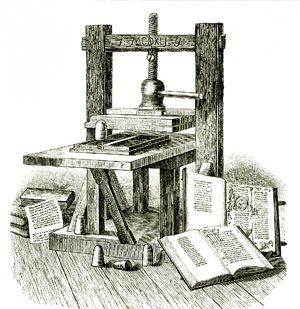More and more people are talking about QR codes lately because of their popularity of use in printed marketing materials and beyond. What exactly is a QR code though? QR is short for quick response. They are codes, similar to barcodes, and they are meant to be scanned by smart phones. A QR code can link to information about a company, its products, promotional information and much more. Many organizations are now including QR codes in their print marketing, but how exactly does a company conduct an effective marketing campaign utilizing these codes?
Marketing with Print and QR Codes
By
Carrie Grove | Fri, Nov 04, 2011
Printed Media and the Environment - What You Need to Know
By
Carrie Grove | Wed, Jul 13, 2011
ChoosePrint.org is a terrific website with great information and facts about the benefits of print. This week I'm sharing some of that information with you. Please comment and let me know what your thoughts are on this subject.
There’s a lot of misinformation out there about the environmental impact of printed media. “Save a tree – don’t print!” “Print is bad for the environment!” “Print is killing the forests!” We’ve all heard these types of thoughts before. However, none of them are true.
The truth is, print is recyclable, renewable and responsible.
Let’s examine the facts:
From sustainable forests to the renewable nature of trees and the recyclability of paper, the print and paper industries have a positive environmental story to tell—one in which print on paper and healthy forests thrive hand-in-hand.
Read More >
There’s a lot of misinformation out there about the environmental impact of printed media. “Save a tree – don’t print!” “Print is bad for the environment!” “Print is killing the forests!” We’ve all heard these types of thoughts before. However, none of them are true.
The truth is, print is recyclable, renewable and responsible.
Let’s examine the facts:
- Print is Recyclable – Nearly all Americans – 87% – have access to curbside or drop-off recycling programs. These programs are extremely popular; currently 63% of all printed materials in the U.S. are recycled, and this number has been growing over time.
These recycled paper fibers are used in paper production (where they can be recycled several times), in the manufacture of construction products and in the production of consumer goods.
- Print is Renewable and Sustainable – Trees are a renewable resource. In fact, there are more acres of forest and more trees standing today than what existed just 20 years ago. Most of the trees used in paper production today are grown on “tree farms” – growing operations that treat trees as a crop, just like broccoli or wheat. Once a section of trees is harvested the land is replanted with more trees.
- Print is Responsible – Just 11% of the world’s forests are used for paper, with the majority of most fiber used to produce paper coming from “waste” products – wood chips, sawmill scraps and recycled paper. In the U.S. the wood used to produce paper all comes from certified forests. There are systems in place to track fiber content from certified lands through to the end product, ensuring that the fiber used to produce paper all comes from sustainable forest sources.
From sustainable forests to the renewable nature of trees and the recyclability of paper, the print and paper industries have a positive environmental story to tell—one in which print on paper and healthy forests thrive hand-in-hand.
TPI Solutions Ink Blog: Printing Degree or Not?
By
Carrie Grove | Tue, Sep 14, 2010
While checking out my social networks today, in an attempt to keep up with this ever-changing world of print, I came across the following blog article posted by Bill Prettyman called "Should Young People Study Print and Print Media" .
COMMENTS
SUBSCRIBE VIA EMAIL
POPULAR ARTICLES
RECENT ARTICLES
POSTS BY TOPIC
- graphic design (102)
- print (62)
- TPI Solutions Ink (42)
- digital printing (36)
- printing (34)
- graphic designer (33)
- typography (30)
- HP Indigo press (28)
- inspiration (27)
- holidays (26)
- printing company blog (22)
- color (19)
- logo design (19)
- Adobe Creative Suite (17)
- infographic (17)
- paper (17)
- photography (17)
- printing company (16)
- illustration (14)
- cards (13)
- custom printed (13)
- TPI Solutions (11)
- marketing (11)
- Design (10)
- wedding invitations (10)
- CMYK (9)
- customer of the month (9)
- marketing with print (9)
- type (9)
- fonts (8)
- posters (8)
- #TypefaceTuesday (7)
- pantone (7)
- white ink (7)
- 2023 calendar (6)
- Christmas (6)
- PMS (6)
- Typeface Tuesday (6)
- Valentines Day (6)
- multi media (6)
- on demand digital (6)
- print media (6)
- tutorial (6)
- variable data printing (6)
- branding (5)
- christmas cards (5)
- greeting cards (5)
- print local (5)
- quiz (5)
- request for quote (5)
- spring (5)
- wedding printing (5)
- St. Patrick's Day (4)
- bleeds (4)
- commercial printer (4)
- digital printing services (4)
- fun facts (4)
- info graphic (4)
- package design (4)
- seasons (4)
- 4th of July (3)
- Boston Marathon (3)
- QR Codes (3)
- advertising (3)
- books (3)
- environment (3)
- fall (3)
- family owned printing company (3)
- high quality digital printing (3)
- history (3)
- invitations (3)
- large format posters (3)
- money saving (3)
- personalization (3)
- self publishing (3)
- #throwbackthursday (2)
- Awards (2)
- Boston Strong (2)
- Mohawk Panoramic Papers (2)
- RGB (2)
- audition headshots (2)
- calendar (2)
- custom printing (2)
- day of wedding printing (2)
- finishing (2)
- free guide (2)
- graphic design trends (2)
- illustrator (2)
- mailing (2)
- mohawk superfine (2)
- note cards (2)
- pdf files (2)
- photoshop (2)
- printed stationery (2)
- printer's wonderland (2)
- programs (2)
- shark week (2)
- shop local (2)
- style sheets (2)
- tips (2)
- video (2)
- wedding invitation printing (2)
- winter (2)
- woman business enterprise (2)
- 2021 calendar (1)
- Academy Awards (1)
- Bleed (1)
- Boston (1)
- Boston Red Sox (1)
- COVID19 (1)
- Cinco de Mayo (1)
- Earth Day, Environment (1)
- Father's Day (1)
- Hanukkah (1)
- Image Resolution (1)
- Mother's Day (1)
- Nift (1)
- Offset Printing (1)
- Opening Day (1)
- Oscars (1)
- Presidents Day (1)
- TPI Headshots (1)
- Thanksgiving, (1)
- The One Fund (1)
- The Salvation Army (1)
- art prints (1)
- artwork (1)
- back to school (1)
- baseball (1)
- book binding (1)
- business cards (1)
- canvas prints (1)
- car magnets (1)
- celebration magnets (1)
- chocolate (1)
- color palettes (1)
- connect (1)
- custom party decorations (1)
- cut out (1)
- direct mail (1)
- download and print (1)
- easter (1)
- envelopes (1)
- event signs (1)
- family (1)
- film (1)
- foil stamping (1)
- food (1)
- foodie (1)
- frosty the pressman (1)
- groundhog day (1)
- halloween (1)
- how to (1)
- indesign (1)
- integrity (1)
- journals (1)
- kickstarter (1)
- local artist (1)
- menus (1)
- metallic (1)
- mom blog (1)
- movie (1)
- new england patriots (1)
- nonprofit organization (1)
- notebooks (1)
- positive thinking (1)
- postage (1)
- postcards (1)
- print packaging (1)
- printable (1)
- printed headshots (1)
- printing for artists (1)
- printing for theater (1)
- printing management (1)
- printing terms (1)
- quotes (1)
- resources (1)
- scanning (1)
- short run (1)
- small business (1)
- social distancing (1)
- specialty substrates (1)
- stock photos (1)
- stop motion animation (1)
- street art (1)
- summer (1)
- summer theater programs (1)
- super bowl (1)
- vintage, (1)
- watercolor artwork (1)
- winter wonderland (1)
POSTS BY MONTH
- December 2023 (1)
- November 2023 (1)
- October 2023 (1)
- August 2023 (1)
- July 2023 (1)
- June 2023 (1)
- May 2023 (1)
- April 2023 (1)
- March 2023 (1)
- February 2023 (1)
- January 2023 (1)
- January 2021 (1)
- July 2020 (1)
- April 2020 (1)
- March 2020 (1)
- February 2020 (1)
- May 2019 (1)
- April 2019 (1)
- July 2018 (1)
- March 2018 (1)
- February 2018 (1)
- January 2018 (1)
- December 2017 (2)
- November 2017 (1)
- October 2017 (1)
- September 2017 (1)
- August 2017 (1)
- July 2017 (1)
- June 2017 (2)
- March 2017 (2)
- February 2017 (2)
- January 2017 (1)
- December 2016 (1)
- October 2016 (2)
- September 2016 (1)
- August 2016 (1)
- July 2016 (2)
- June 2016 (2)
- May 2016 (1)
- April 2016 (4)
- March 2016 (1)
- January 2016 (2)
- December 2015 (3)
- November 2015 (1)
- September 2015 (2)
- August 2015 (2)
- July 2015 (1)
- June 2015 (1)
- May 2015 (1)
- April 2015 (1)
- March 2015 (2)
- February 2015 (2)
- January 2015 (1)
- December 2014 (1)
- November 2014 (1)
- September 2014 (2)
- August 2014 (1)
- July 2014 (2)
- June 2014 (2)
- May 2014 (1)
- April 2014 (3)
- March 2014 (3)
- February 2014 (1)
- December 2013 (2)
- October 2013 (1)
- September 2013 (2)
- August 2013 (1)
- July 2013 (2)
- June 2013 (1)
- May 2013 (1)
- April 2013 (2)
- March 2013 (2)
- February 2013 (3)
- January 2013 (3)
- December 2012 (3)
- November 2012 (1)
- October 2012 (3)
- September 2012 (2)
- August 2012 (1)
- July 2012 (1)
- June 2012 (3)
- May 2012 (1)
- April 2012 (2)
- March 2012 (4)
- February 2012 (2)
- January 2012 (3)
- December 2011 (3)
- November 2011 (2)
- October 2011 (3)
- September 2011 (2)
- August 2011 (1)
- July 2011 (1)
- June 2011 (3)
- May 2011 (1)
- April 2011 (2)
- March 2011 (1)
- February 2011 (2)
- January 2011 (3)
- December 2010 (2)
- November 2010 (2)
- September 2010 (2)
- August 2010 (1)
- July 2010 (3)
- June 2010 (5)



